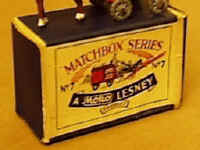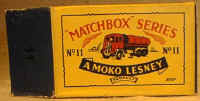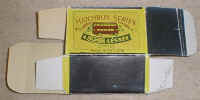Boxes
(NONE of these cars are for sale).
Michael J. Stannard's now out of print book classified the various box types used over the years to package Matchbox models. He readily states that there are many variations that would involve a substantial catalog, and that his account is just the basic listing. Dates given are an approximate guide for which model were released in which type box. There was a transitional period between box changes as dates of release and deletion show and one can not assume that all models issued during these periods would have been available in both (or all) types of boxes.
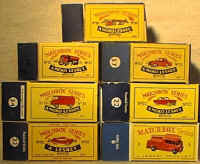
row 1: B1;
row 2: B2, B3;
row 3: B4, B5;
row 4: C, D
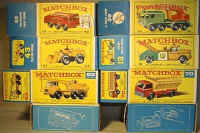
row 1: E1, E2;
row 2: E3, E4;
row 3: F1, F2;
row 4: F side panel showing working action of model
Series A – "MOKO Script" [no variations]. 1953 and 1954 for models numbered 1 to 7 only. The first series boxes had yellow faces with a line drawing of the model in black, or black and red. "MATCHBOX SERIES" in red was at the top. The model number was on either side of the model, with "A MOKO LESNEY PRODUCT" and "MOKO" in script in a black scroll below. The end flaps and one side were dark blue, and the other side was dark purple/brown representing the striker on the matchbox. [photo courtesy of Roger Gray 6/30/99, cf. reproduction series A below
Series B. MOKO "Capitals" box. 1955 to 1962. This series was similar to the first, but had "MOKO" in capitals (not script) in the Scroll, Additional small print appeared outside the face border line on later boxes. The end flaps were altered several times as follows:

B3. Black model number in white circle

B4. Black model number in white circle, model description in black letters on white panel.

B5. Black model number in white circle, model description in white letters

Series C.. LESNEY box [no variations], 1961 to 1963. This series was similar to B, but with "MOKO" deleted from the scroll following Lesney's takeover of J. Kohnstam Ltd, in 1959.
Series D. "MATCHBOX Series" (curved box) [no variations]. 1962 to 1967. This was a new design of box with a colored illustration of the model on the yellow faces. The scroll was deleted and "A LESNEY PRODUCT" was printed under the illustration. Drawings to illustrate working features of the models appeared on the faces of some boxes. Various small print in red appeared outside the border lines. Box sides were as before (dark blue/purple blue, or both dark blue, or both a lighter medium blue shade. End flaps, which were dark or medium blue had the model number and description in white lettering -- either lettering with serifs or later, plain block lettering.
Series E. "MATCHBOX" (CURVED or ARCHED) 1964 TO 1970. THIS DESIGN HAD "Series" moved to below "MATCHBOX", and the model number either side of "A LESNEY PRODUCT", with small print outside the border lines. Sides were either both dark blue or both medium blue. Blue end tabs were the same shade of blue as the sides, with four variations

E1 white model numbering and description

E2. White model number and descriptions plus a black line drawing in a white circle showing the model's operating features

E3. Yellow model number, white lettered descriptions and a color picture of the model on a yellow panel
E4. Yellow model number, white lettered description, a color picture of the model on a yellow panel with "MATCHBOX" above it in white lettering
Series F. "MATCHBOX (straight) 1958 to 1970. "MATCHBOX" was now in a straight line with the model number to the right in white on a blue panel. Colored illustrations remained the same with a black line above and below the picture replacing the all-around border. Small print still appeared at the top and bottom of the faces. Sides and end flaps were medium blue end flaps had a yellow panel with "MATCHBOX" at the top in red, a colored picture of the model in the middle, and a red model number and black description on the bottom. Although many models were converted to Superfast wheels in 1969 and 1970, not all were immediately affected and these continues to be released in this type box until converted or deleted. Models that were not suitable for conversion were in turn released in Series G, non-Superfast boxes.

F1. "SERIES" in white under the model number in blue square
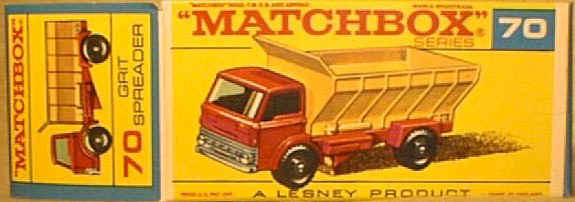
F 2. "SERIES" in red under the "OX" of "MATCHBOX" "A LESNEY PRODUCT' is below the bottom line on the box face as on F1
F3. "SERIES" under the "OX" of "MATCHBOX" and "LESNEY PRODUCT & CO LTD LONDON ENGLAND" below bottom line [NO PHOTO AVAILABLE]
F4 "SERIES" under "OX" of "MATCHBOX" and "MATCHBOX IS THE REG'D TM OF LESNEY PRODUCTS & CO LONDON ENGLAND" below the bottom line [NO PHOTO AVAILABLE]
F5 "SERIES" under "OX" of "MATCHBOX", and "MATCHBOX REG'D TM LESNEY PRODUCTS & CO LTD LONDON ENGLAND [NO PHOTO AVAILABLE]

F "SERIES" box sides with white line drawing of model function [other view of this box at f1 above]
Series G. "MATCHBOX" (slanted, non-Superfast) [no variations] 1970 to 1973. Since a few models were not suitable for conversion to Superfast wheels, their boxes were produced in the Superfast design but without "Superfast" on the faces and end flaps. These were similar to series F but with the top line deleted above the model illustration on the faces and end flaps. All small print was now below the bottom line. The background to the model illustration had lines to give the impression of speed. [NO PHOTO AVAILABLE]
I purchased several reproduction boxes to see what they look like, and they are surprisingly good. The key to identifying reproduction boxes seems to be in the way they are made. An original [old] box is photocopied on a color copier on card stock or paper which is then attached to card stock. Sometimes you can see where the photocopy reproduces a crease or other mark [missing color from creases or other wear, writing etc. were visible on each of the several reproduction boxes I purchased], and the folds do not always line up exactly where they should. Looking carefully at these marks will show whether they are "reproduced" or a result of actual "wear" or abrasion, etc. There is a shine to the reproduction paper that is not apparent on the old original boxes. The color, particularly visible on the light or mid-dark blue sides and ends tends to be mottled, and not even or consistent, and the yellow on the face appears to have some red toning [this depends on the exact colors being reproduced and may be more or less evident]. The image etc. is not quite as clear as an original. I have not done exacting comparisons, and it probably would take a side by side comparison, but the die cuts to produce the shape of the box seem a little off, perhaps most visible on the shape of the end flaps. The card stock used on the reproduction boxes tends to be but is not always pure white, whereas on a "real" box the paper visible inside is more of a straw-brownish color either originally or with age. But, one of the reproduction boxes I purchased is a similar straw-brownish color [and this will likely become more common as the copies become better]. Reproductions reportedly tend to be thicker as they had to stick the color Xerox paper onto card, but I have not verified this and it is not obvious to me on simple inspection.
Note marks and "wear" (white) in copy, esp. at creases etc. [on close inspection this is lack of color from worn areas on the box that was copied]; writing on the end flap of the top box; mottled color esp. apparent in the blue end panels on the middle box; and the reddish mottled effect in the yellow face of bottom box which is apparent in the real "reproduction", and shine generally as demonstrated by the reflected flash from the camera. The top box inside is distinctly straw-brownish compared to the white on the middle and lower boxes.
Variation descriptions Lesney's Matchbox® Toys, Regular Wheel Years, 1947–1969, © 1992, & Encyclopedia of Matchbox® Toys, © 1997, 1999 [2nd Ed.], by Charlie Mack, reprinted with permission
© 1996–2017, Frank C. Carnahan, all rights reserved • contact: • fcarnahan.com
